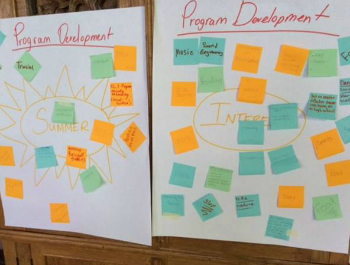
Margarita de Escontrias, CEO, Cabrillo Economic Development Corp.
Challenge: Cabrillo Economic Development Corp.’s challenge was to evolve from a one-stop shop for resident services, which would require changes in our organizational culture and input from residents about their needs and preferences. We needed to strengthen our partnerships and work harder to know our residents.
Cabrillo Economic Development Corporation (CEDC) provides comprehensive housing services and community economic development activities through a holistic community-centered approach that encourages self-sufficiency for individuals and families who are most lacking in opportunity in Ventura and Santa Barbara Counties, as well in adjacent areas in Los Angeles County.
In the spring of 2015 our Community Building and Neighborhood Revitalization (CBNR) team assessed service obligations and social trends at our twenty-four affordable housing developments throughout Ventura County. Our team met with our diverse community members including seniors, farm workers, low-income and special needs households and developed a strategy to prioritize fundamental programs and services and enhance communication throughout the entire portfolio. We wanted to understand what programs and services had the greatest impact to our residents and why. We thought using resident surveys would be the most efficient and direct means of getting resident input.
The surveys we used to assess future program and service development were surprisingly unsuccessful. This was the first time our staff developed a plan of action with our residents and, as we later discovered, it was the first time our residents were asked to share an opinion regarding their ideas, interests or goals. This was especially true in our farm worker communities. Residents often felt they would negatively impact their housing if they answered a question incorrectly or shared too much information with the staff. When a staff member asked “What types of programs or services would you like to see at your property?” - the room was silent. Without a previously established relationship or connection to our communities, our team did not have the necessary sense of trust developed to pose these questions. The goal of this forum was to create a sense of trust between CEDC and our residents and indirectly increase the opportunity to create stronger connections to available opportunities, resources and social networks.
While we continually use informal feedback from residents to shape our programs, we decided to take a more formal and quantifiable approach. In order to make the most of these forums, our CBNR team distributed identical sticky notes to every resident in the room. Our team re-asked the initial question, “What types of programs or services would you like to see at your property?” But now we said, “Write down your answer on your sticky note. When you are finished, raise your hand and we will collect them.” We went from zero responses to 19 responses.
 Thus the sticky note provided an opportunity for our residents to be heard without actually speaking and to interact, to share, to participate, to vote, to request—all while not being ridiculed or belittled. The sticky note created a safe space where all ideas and suggestions were welcome. Through this process, we learned that our residents were interested in educational programs such as children’s programs, health programs and English as a Second Language. Our residents all shared the same desire: to learn. By working collaboratively with residents, we identified assets and strengths of the community itself and we were able to implement changes to engage residents.
Thus the sticky note provided an opportunity for our residents to be heard without actually speaking and to interact, to share, to participate, to vote, to request—all while not being ridiculed or belittled. The sticky note created a safe space where all ideas and suggestions were welcome. Through this process, we learned that our residents were interested in educational programs such as children’s programs, health programs and English as a Second Language. Our residents all shared the same desire: to learn. By working collaboratively with residents, we identified assets and strengths of the community itself and we were able to implement changes to engage residents.
This reciprocal approach to community building provided an opportunity for our residents to develop recommendations that reflected the character and values of their communities. These interactions allowed communities to improve the quality of life and character of their neighborhoods by incorporating their diverse cultural backgrounds. The result was a three-part phased implementation strategy with a progression of activities that starts by identifying our core service audience—CEDC residents—and ends with inclusive, data-driven strategic and resource planning based on the input from residents gathered in the sticky notes.
In phase one, we developed Service Planning Areas around each property in our portfolio throughout Ventura County, focusing first on most commonly underserved communities. We used Google mapping technology to identify pre-existing assets in the community, such as schools, libraries, community organizations and places of worship within one-fourth of a mile of a CEDC property. We were able to leverage existing contributions to the community and establish a stronger relationship with potential partners. We now prioritize children’s programs and health-related classes programs and work more closely local universities and health care providers to ensure we can offer programs on a regular basis.
Throughout this process we learned two lessons:
- we needed to know more about our residents
- we needed a more strategic approach to our partnerships. The sticky note proved to be the key to creating and adopting a new strategy: after having our discussion forums with our residents, we had a better idea of what was actually happening in each of our communities. Therefore, every strategic planning meeting with partners was much more intentional; we had a stronger understanding of our expectations, shared responsibilities, goals and outcomes.

